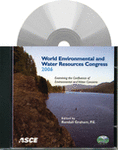Evaluation of Bench Scale SBR for Removal of Nutrients from Domestic Wastewater
Publication: World Environmental and Water Resource Congress 2006: Examining the Confluence of Environmental and Water Concerns
Abstract
Wastewater contains organic matter, nutrients like nitrogen and phosphorus, pathogens and other pollutants and its discharge in water bodies causes environmental problems like eutrophication, fish kills and odours. Research has been carried out over the years to find effective biological treatment methods to remove nutrients and in this direction the sequencing batch reactor (SBR) has demonstrated good potential for complete removal of phosphorus and nitrogen from domestic wastewater. Bench scale studies on SBR were carried out to assess its ability to develop phosphorus accumulating organisms (PAOs) in short period of time with seed material taken from sludge of septic tank and feed used was synthetic wastewater. Various researchers had reported that several months were taken to develop enhanced biological phosphorus removal (EBPR) sludge whereas in this study it was found that in a short duration of 21 days, the COD removal was 73.4% in anaerobic phase while the phosphorus removal yield (PRY) was 92%, which indicated that PAOs were grown in sufficient numbers. After enrichment, the SBR was fed with raw domestic wastewater which contained COD (260 mg/l), ammonia nitrogen (59 mg/l) and phosphorus (15.3 mg/l). The effluent at the end of the SBR cycle contained less than 15 mg/l of COD, ammonia nitrogen of less than 1 mg/l, nitrate nitrogen in the range of 10 to 11 mg/l and phosphorus in the range of 0 to 1.5 mg/l. The denitrification observed was 100% in the anaerobic phase. To remove nitrate nitrogen completely, an anoxic batch reactor was started and the final effluent contained COD of less than 20 mg/l, nitrate nitrogen less than 1 mg/l, phosphorus concentration less than 2.2 mg/l and ammonia nitrogen concentration of less than 2 mg/l. Kinetic study was done to determine the rate at which microbes treat wastewater to remove nutrients and it was observed that COD uptake was 0.058 mg COD/mg VSS within one hour from the start of anaerobic phase and corresponding phosphorus release was 3.49*10–4 mg phosphorus/ mg VSS. The denitrification rate observed was 3.40*–4 mg nitrate nitrogen/ mg VSS. The kinetic study also showed the phosphorus uptake was 5.04*10–3 mg phosphorus/ mg VSS and the nitrification was 3.33*10–3 mg ammonia nitrogen/ mg VSS in the first one hour of aerobic phase.
Get full access to this chapter
View all available purchase options and get full access to this chapter.
Information & Authors
Information
Published In
Copyright
© 2006 American Society of Civil Engineers.
History
Published online: Apr 26, 2012
ASCE Technical Topics:
- [Inorganic compounds]
- Ammonia
- Biological processes
- Chemical compounds
- Chemical elements
- Chemical processes
- Chemicals
- Chemistry
- Environmental engineering
- Municipal wastewater
- Nitrates
- Nitrogen
- Nutrient pollution
- Organic compounds
- Oxygen demand
- Phosphorus
- Pollution
- Salts
- Waste management
- Wastewater management
- Water pollution
- Water treatment
Authors
Metrics & Citations
Metrics
Citations
Download citation
If you have the appropriate software installed, you can download article citation data to the citation manager of your choice. Simply select your manager software from the list below and click Download.
